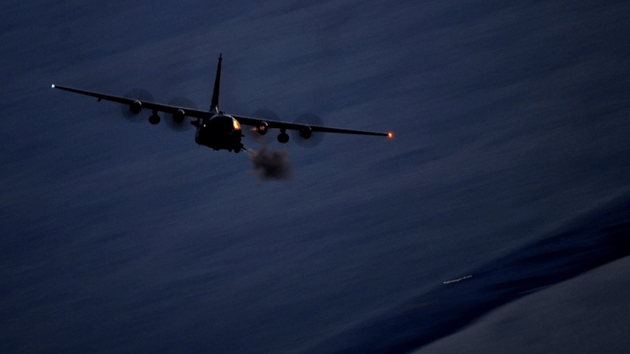(WASHINGTON) — The U.S. military fired back at Iran-backed militants who injured several troops in Iraq early Tuesday morning local time, according to U.S. officials.
The militants launched a ballistic missile attack from a truck against U.S. forces at al-Asad Airbase in western Iraq, leaving several service members with minor injuries, according to U.S. officials.
“I can confirm an attack last night by Iran backed militias using a close-range ballistic missile against U.S. and coalition forces at al-Assad Airbase in Iraq, which resulted in several non-serious injuries and some minor damage to infrastructure,” said Deputy Pentagon Press Secretary Sabrina Singh.
“We can confirm an attack last night by Iran-backed militias using a close-range ballistic missile against us and coalition forces at Al-Asad airbase, which resulted in eight injuries and minor damage to infrastructure. Immediately following the attack, a U.S. military AC-130 aircraft in the area conducted a self defense strike against an Iranian-backed militia vehicle and a number of Iranian-backed militia personnel involved in this attack,” said Pentagon Press Secretary Brig. Gen. Pat Ryder.
Singh said this was the first time a close-range ballistic missile was used to target U.S. forces since the current spate of attacks against them began in Iraq and Syria on October 17. The militants fired two of these missiles at the base, according to a U.S. official.
According to Singh, the U.S. response was “immediate.”
“Immediately following the attack, a U.S. military AC-130 aircraft in the area conducted a self-defense strike against an Iranian-backed militia vehicle and a number of Iranian-backed militia personnel involved in this attack,” Singh said.
“This self-defense strike resulted in some hostile fatalities,” she added.
Singh would not detail the other un-planned, immediate self-defense strikes when asked by ABC News’ Elizabeth Schulze at the briefing. Singh would also not say whether the AC-130 was loitering in the area in anticipation of such a strike-counterstrike scenario when asked by ABC News.
ABC News also asked whether the American aircraft could have intervened to prevent the attack on U.S. forces.
“I don’t believe it was in a position to prevent. I believe it was in the air and saw it happen in real time,” she responded.
There have been previous unpublicized cases of the U.S. military striking back in this fashion, according to Singh.
“We have had other cases where we have responded in retaliation when we were able to identify the point of origin, so it’s not our first time,” she said.
She made clear that these previously unacknowledged immediate counterstrikes are separate from the three rounds of pre-planned airstrikes against Iran-linked militants the U.S. has announced since Oct. 17.
“We have taken three strikes in self defense, but those were pre-planned. So just a little different here in terms of the nuance of how we’re talking about these this self-defense strike we took,” she said.
An American AC-130 gunship that was airborne in the region at the time observed the attack and tracked the militants’ vehicle and then fired back. The U.S. assesses several of the Iran-linked fighters were killed in the swift counterstrike.
The missile attack on al-Asad is the 66th such attack from Iran proxies against U.S. forces in Iraq and Syria since Oct. 17, when a near-daily spate of aggression began. Roughly 70 U.S. troops have received minor injuries or traumatic brain injuries in that time, according to the Pentagon.
Last week, U.S. fighter jets hit a weapons storage facility and a command-and-control center in Syria that Secretary of Defense Lloyd Austin and other officials said were used by the Iran-backed groups to conduct its attacks. The U.S. launched two other rounds of similar retaliatory airstrikes since mid-October on Iran-linked facilities, but unlike Tuesday’s AC-130 counterattack, these were planned in advance, as opposed to being targeted in real time.
The U.S. has troops in Iraq and Syria as part of its mission to defeat the remnants of the Islamic State.
Copyright © 2023, ABC Audio. All rights reserved.






